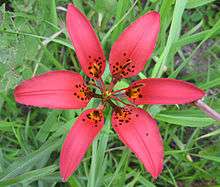Lilium philadelphicum
| Wood lily | |
|---|---|
 | |
| Scientific classification | |
| Kingdom: | Plantae |
| (unranked): | Angiosperms |
| (unranked): | Monocots |
| Order: | Liliales |
| Family: | Liliaceae |
| Genus: | Lilium |
| Species: | L. philadelphicum |
| Binomial name | |
| Lilium philadelphicum L. | |
| Synonyms[1] | |
| |
Lilium philadelphicum, also known as the wood lily, Philadelphia lily, prairie lily or western red lily, is a perennial species of lily native to North America.[2]
Distribution
The plant is widely distributed in much of Canada from British Columbia to Quebec, and parts of the United States (Northeast and Great Lakes regions plus the Rocky and Appalachian Mountains).[3][4]
Description
Lilium philadelphicum grows to a height of approximately 30 to 90 centimeters. It produces red or orange blooms between June and August.[5]
Varieties
- Lilium philadelphicum var. andinum — western wood lily, native to Midwestern U.S., Great Plains, and Western U.S. regions. [6] It is the floral emblem of Saskatchewan province in Canada, and is on the flag of Saskatchewan. [7][8][9]
Conservation
Lilium philadelphicum is listed as an endangered species in Maryland, New Mexico, Tennessee and North Carolina.[3][10] Its status is a threatened species in Kentucky and Ohio.[3]
As the Saskatchewan provincial floral emblem it is protected under the Provincial Emblems and Honours Act, and cannot be picked, uprooted or destroyed in any manner. [8][7]
Toxicity
Cats are extremely sensitive to lilly toxicity and ingestion is often fatal.[11][12][13] Households and gardens that are visited by cats are strongly advised against keeping this plant or placing dried flowers where a cat may brush against them and become dusted with pollen that they then consume while cleaning.[14] Suspected cases require urgent veterinary attention.[15]
Rapid treatment with activated charcoal and/or induced vomiting can reduce the amount of toxin absorbed (this is time-sensitive so in some cases vets may advise doing it at home), and large amounts of fluid by IV can reduce damage to kidneys to increase the chances of survival.[15]
References
- ↑ Kew World Checklist of Selected Plant Families
- ↑ Flora of North America Vol. 26 Page 180 Wood lily, lis de Philadelphie Lilium philadelphicum Linnaeus, Sp. Pl., ed. 2. 1: 435. 1762.
- 1 2 3 "PLANTS Profile for lilium Philadelphicum". USDA. Retrieved 24 May 2016.
- ↑ Biota of North America Program 2014 county distribution map
- ↑ "Plant detail: Lilium philadelphicum". Evergreen. 2008. Retrieved 2008-07-09.
- ↑ NPIN: Lilium philadelphicum var. andinum (western wood lily)
- 1 2 "Government House Gardens Showcase Western Red Lily". Government of Saskatchewan. 2005-07-21. Archived from the original on 2011-06-11. Retrieved 2008-07-09.
- 1 2 "Saskatchewan's Provincial Flower". Government of Saskatchewan. Retrieved 2008-07-09., designated in 1941.
- ↑ "Saskatchewan". Government of Canada. 2013-08-20. Retrieved 2015-07-18.
- ↑ "Endangered Plants of North Carolina". North Carolina Natural. February 2000. Retrieved 2008-07-09.
- ↑ Frequently Asked Questions No Lillies For Cats.
- ↑ Fitzgerald, KT (2010). "Lily toxicity in the cat". Top Companion Anim Med. 25: 213–7. PMID 21147474. doi:10.1053/j.tcam.2010.09.006.
- ↑ Lilies Pet Poison Helpline.
- ↑ The Valentine bouquet that killed my cats: Mother's Day warning on lethal lilies Daily Mail.
- 1 2 Lily Poisoning in Cats. Pet MD.
External links
- USDA Plants Profile for Lilium philadelphicum (wood lily)
- Lady Bird Johnson Wildflower Center Native Plant Information Network−NPIN: Lilium philadelphicum (Wood lily) — with horticultural info.
- University of Michigan at Dearborn: Native American Ethnobotany of Lilium philadelphicum
| Wikimedia Commons has media related to Lilium philadelphicum. |